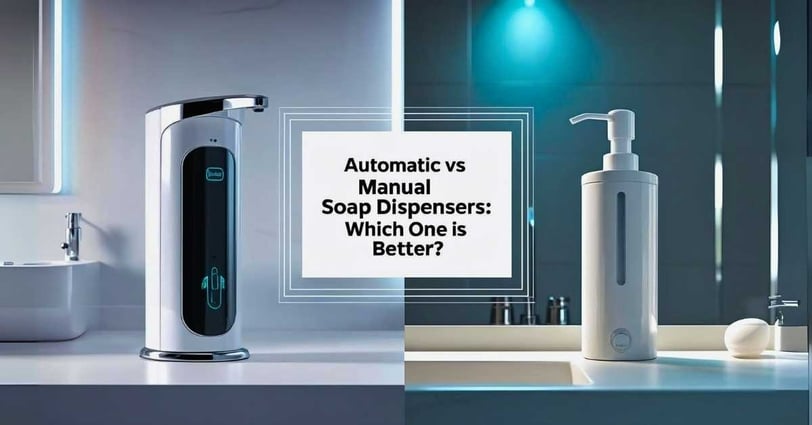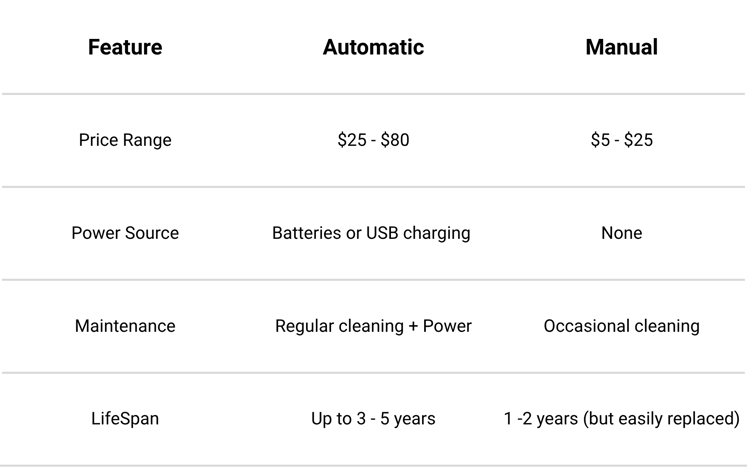Automatic vs Manual Soap Dispensers: Which One Is Better?


When Olivia and her husband moved into their new home in Austin, Texas, they made a promise to prioritize hygiene and comfort. Post-2020, germs were top of mind. Olivia picked up an automatic dispenser she saw on a tech blog, thrilled about going touchless in their new bathroom. But after two weeks of inconsistent soap flow and a battery dying mid-handwash, her excitement dimmed. Her husband, on the other hand, stuck with a $9 manual pump that worked like a charm. It sparked the debate many households now face: should you go high-tech, or stick with the basics?
If you're navigating the same decision, you're in the right place. This article breaks down everything you need to know.
Automatic: Easy to install but needs occasional upkeep (like nozzle cleaning and recharging).
Manual: Virtually maintenance-free. Just refill and clean now and then.
Both benefit from weekly wipe-downs, especially in shared or high-use environments.
👨🔧 Installation & Maintenance
Automatic options shine when it comes to family settings or homes with elderly members. No-touch operation reduces the risk of cross-contamination and encourages consistent use. Manual options, while functional, need frequent cleaning to maintain the same level of hygiene.
Learn more about other hygiene-friendly innovations in What Are Smart Bathroom Accessories? A Beginner’s Guide.
🧼 Hygiene & Safety
If you're comparing long-term value, automatic versions win on features, while manual models dominate on dependability.
Pros:
Budget-friendly: Low cost and widely available
Reliable: No power needed, works every time
Simple: Easy for kids and seniors to use
Cons:
Requires contact: Potential germ spread
Can get messy: Soap drips or clogged pumps
Less innovative: Doesn’t match high-tech setups
💪 Pros & Cons of Manual Soap Dispensers
Pros:
Touchless hygiene: Ideal for reducing germs
Convenience: Great for multitasking in kitchens or bathrooms
Modern appeal: Complements smart bathrooms
Cons:
Battery maintenance: Regular charging or replacements
Sensor issues: Can misfire or fail
Higher cost: Initial purchase and upkeep are pricier
In fact, according to Allied Market Research, the U.S. touchless dispenser market is projected to reach $1.2 billion by 2026, largely driven by hygiene concerns post-pandemic.
💡 Pros & Cons of Automatic Soap Dispensers
Automatic models use sensors to release soap hands-free. They're battery-powered or rechargeable and popular in smart homes and hygiene-conscious environments.
Manual models require a press or pump. They're simple, reliable, and found everywhere from households to offices.
Both serve a similar purpose but offer very different experiences depending on the user's needs and environment.
🧴 Overview of Both Dispenser Types
Pleasure for us to Assist You Further...
There’s no universally “better” option—just a better fit for your routine. Whether you're after sleek automation or simplicity that just works, the right choice comes down to your habits, priorities, and who uses the space most.
So, which type suits your bathroom better?
📆 Conclusion
No more second-guessing which type fits your lifestyle
Clear hygiene vs cost analysis
Better decisions for family or elderly members
Realistic expectations for upkeep and performance
✅ What This Solves for You
Families & Kids: Automatic — fun and hygienic
Tech Enthusiasts: Automatic — pairs well with other smart gadgets
Seniors: Automatic — touch-free and accessible
Renters & Budget Buyers: Manual — cost-effective and simple
If you're shopping for the tech-lover in your life, check out Smart Bathroom Gifts for Father’s Day.
🧠 Which One Is Better for Different Users?


